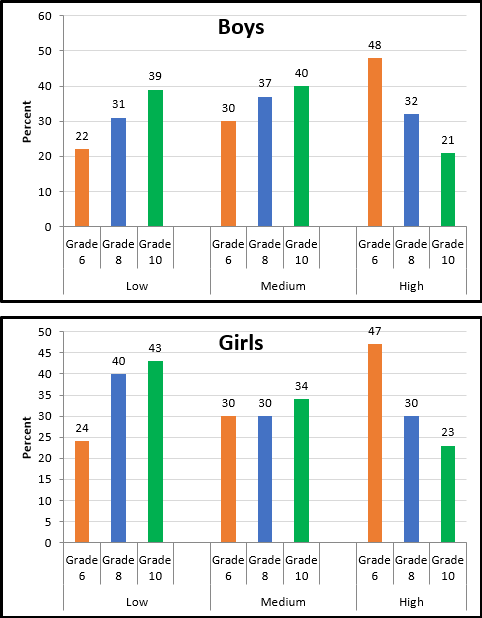7.3.4 Percentage of youth who report low, medium and high levels of community support, by gender and grade, Canada, 2014

Source: CICH graphic created using data from Health Behaviour in School-aged Children in Canada: Focus on Relationships, 2015.
According to a scale* measuring youth in Grades 6, 8 and 10 reports of community support, there were differences in reported community support among Grade levels.
Grade 6 students were less likely to report having low levels of community support and more likely to report having high levels of support than were students in Grades 8 and 10.
The reports were similar between boys and girls.
*The scale is based on the following questions:
People say ‘hello’ and often stop to talk to each other on the street.
It is safe for younger children to play outside during the day.
You can trust people around here.
There are good places to spend your free time (e.g., recreation centres, parks, shopping centres).
I could ask for help or a favour from neighbours.
Answers: Strongly disagree; Disagree; Neither agree nor disagree: Agree; Strongly agree
Implications
Communities can support the health and well-being of children and youth by providing a physically and psychologically safe environment.1 Community support can positively influence the physical health of young people2, their mental health3, and their performance at school.4
According to the Health Behaviours Survey of School Age Children, community support is associated with positive health outcomes. However, the association is not as strong as those of family support and school climate. Young people with high community support were more likely to be physically active, have the recommended number or hours of sleep, more likely to eat well, e.g., fruits and vegetables and not drinking soft drinks and were less likely to go to bed or to school hungry. They had higher self-reported life satisfaction and were less likely to be bullied or bully others. They were less likely to smoke, drink alcohol or use cannabis.5
1Vyncke, V., De Clercq, B., Stevens, V., Costongs, C., Barbareschi, G., Jónsson, S. H., Curvo, S. D., Kebza, V., Currie, C., & Maes, L. (2013). Does neighbourhood social capital aid in levelling the social gradient in the health and well-being of children and adolescents? A literature review. BMC Public Health, 13, 65.
2Morgan, A., & Haglund, B. J. A. (2009). Social capital does matter for adolescent health: Evidence from the English HBSC study. Health Promotion International 24(4), 363-372.
3McPherson, K., Kerr, S., McGee, E., Morgan, A., Cheater, F., McLean, J., & Egan, J. (2014). The association between social capital and mental health and behavioural problems in children and adolescents: An integrative systematic review, BMC Psychology, 2(1), 7.
4Rothon, C., Goodwin L., & Stansfeld S. (2012). Family social support, community “social capital” and adolescents’ mental health and educational outcomes: A longitudinal study in England. Social Psychiatry and Psychiatric Epidemiology 47(5), 697-709
5Freeman JG, King M and Pickett W. Health Behaviour in School-aged Children (HBSC) in Canada: Focus on Relationships. 2016.
http://healthycanadians.gc.ca/publications/science-research-sciences-recherches/health-behaviour-children-canada-2015-comportements-sante-jeunes/index-eng.php
